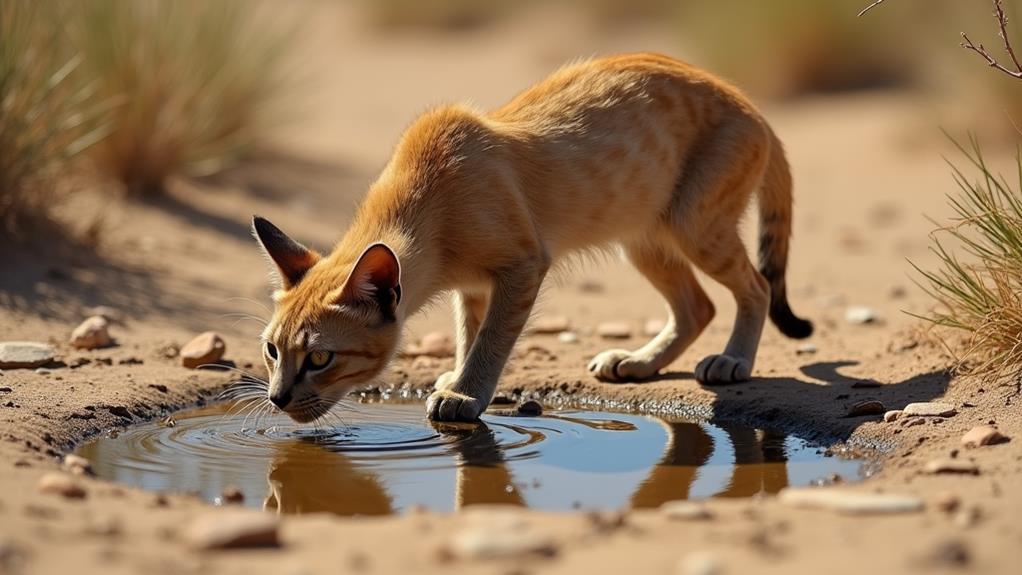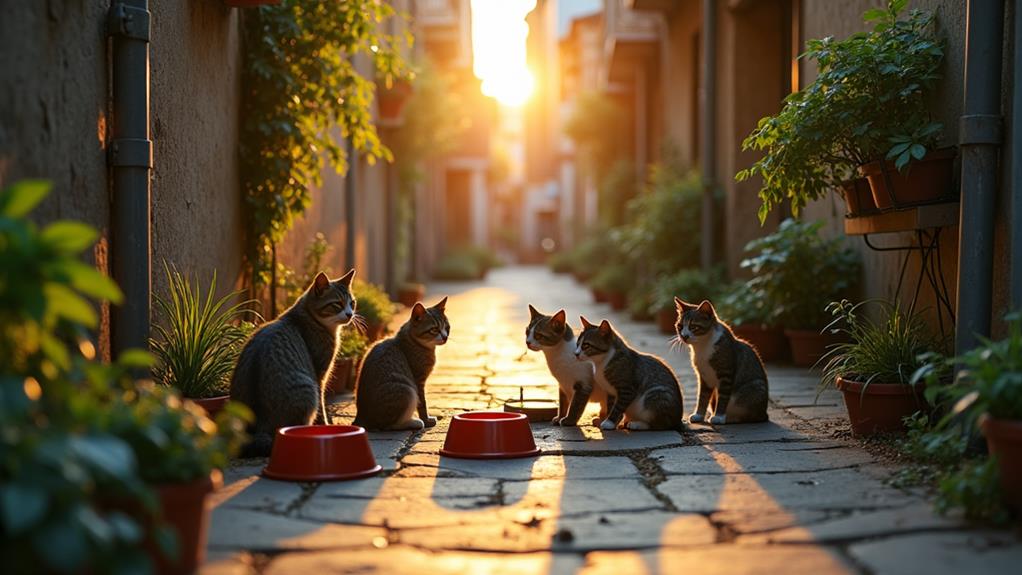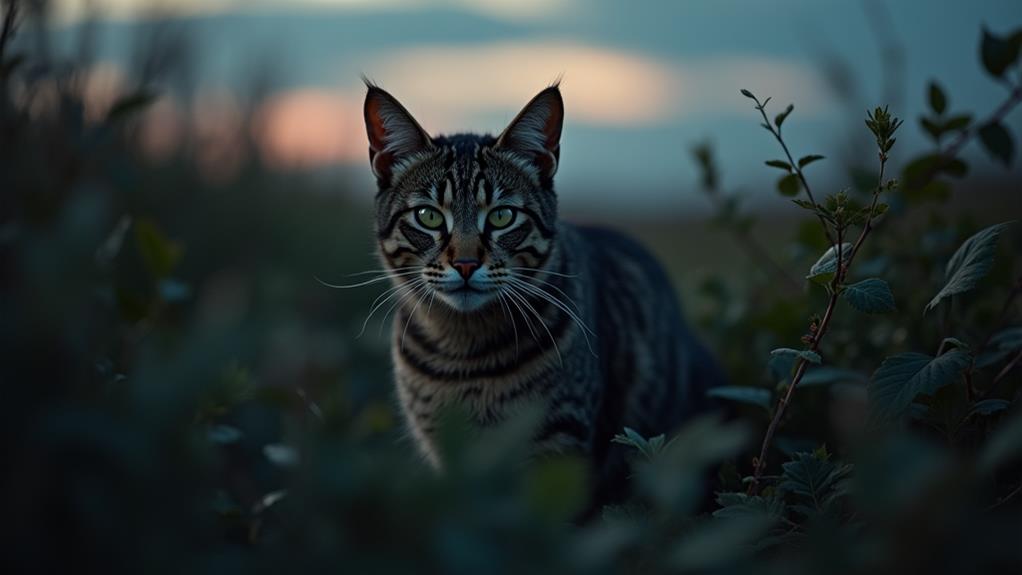How Long Can a Feral Cat Survive Without Eating? What You Should Know

A feral cat can survive without food for about one to two weeks if it has water, but its health can rapidly decline after just a couple of days. Without regular nutrition, they face serious risks like weakness, dehydration, and hepatic lipidosis, a potentially life-threatening liver condition. It's essential to guarantee feral cats have reliable food sources to maintain their health. Signs of malnutrition include significant weight loss and dull coats, while behavioral changes might signal trouble. Understanding these can help you better support their well-being and tackle issues before they escalate. Investigate further to make a difference in their lives.
Feral Cats' Survival Time
Regarding feral cats and their survival without food, they can hang on for about 1-2 weeks if they've got access to water. However, this doesn't mean they're thriving. Without consistent nutrition, their health starts to decline rapidly after only a few days. Fasting for more than two days introduces significant health risks, including weakness and potential for hepatic lipidosis. It's vital to understand that while feral cats might survive weeks without food, their general well-being is compromised.
Feral cats often experience fluctuating food availability, which means they might not eat for several days if reliable food sources aren't present. During these times, they may retreat to safer areas, making them appear hidden or unwell. This behavior highlights the significance of monitoring their actions closely. Access to water provides a key lifeline during such fasting periods, enabling them to survive longer than they would without it.
Ultimately, reliable food sources are critical for these cats. Consistent access to proper nutrition guarantees they don't just survive but can maintain a healthier state. By observing and understanding their behavior, you can better support their needs and improve their chances of thriving.
Health Risks of Starvation
Encountering prolonged periods without food, feral cats face severe health risks that can quickly escalate. Starvation leads to malnutrition, where the lack of fundamental nutrients severely impacts their bodies. Feral cats depend heavily on protein for energy, and fasting causes their fat reserves to deplete. This depletion can overwhelm their liver, leading to a dangerous condition known as hepatic lipidosis. This condition, often referred to as "fatty liver disease," can be life-threatening and requires immediate attention.
When a feral cat refuses to eat for more than 24 hours, it may signal underlying health issues. This situation demands urgency and should prompt a veterinary consultation as quickly as possible. Ignoring these signs could result in severe complications, making timely intervention critical.
It's important to monitor feral cats for signs of lethargy or illness, as these could indicate starvation or other health concerns. Energy depletion can quickly lead to a downward spiral in their health, with rapid deterioration following just three days of fasting. Understanding these health risks is significant to ensuring the well-being of feral cats and taking appropriate measures to prevent starvation-related complications.
Importance of Hydration

Frequently overlooked, hydration is vital for the survival of feral cats. Without access to fresh water, these cats can begin to suffer from dehydration in as little as 24 hours. Dehydration is a severe issue that can lead to organ stress and, if not addressed, potential organ failure. It's essential for their comprehensive health that feral cats have a reliable source of water to facilitate regular drinking habits.
When feral cats don't eat, they miss out on the fluid intake typically provided by food, especially wet food. This absence increases their risk of dehydration even more. Hence, ensuring a consistent supply of fresh water becomes even more important. Environmental factors like high temperatures or increased activity levels can exacerbate the risk of dehydration, further stressing the significance of adequate hydration.
To support the health of feral cats, you should prioritize providing a clean and reliable water source. This will encourage regular drinking and help maintain their comprehensive health, reducing the risk of severe health issues. Ensuring that feral cats have access to fresh water not only aids in their survival but also greatly improves their quality of life.
Signs of Malnutrition
Recognizing signs of malnutrition in feral cats is vital for their well-being. When feral cats go without food for more than a few days, they start showing signs of malnutrition. You might notice significant weight loss and a dull coat, indicating health deterioration. These cats can survive 1-2 weeks without eating, but after just three days, their health begins to decline. Prolonged periods without food can lead to serious health issues like hepatic lipidosis, a condition particularly dangerous after several days of fasting.
Behavioral changes are another important indicator of malnutrition. Feral cats may become more aggressive or withdraw from social interactions. Such changes can hint at their struggle to cope with hunger and stress. Monitoring their feeding habits becomes vital at this stage. A sudden decrease in food intake might signal underlying health problems that call for immediate intervention.
If you notice these warning signs, timely action is required. Addressing malnutrition early can prevent further health complications. By staying vigilant and understanding these signs, you can help guarantee the feral cats in your community remain healthy and resilient despite their challenging circumstances.
Supporting Feral Cat Colonies

Supporting feral cat colonies is vital because these cats often struggle to find consistent food sources, especially during harsh weather conditions. By establishing feeding stations, you can provide fundamental nutrition to these cats, enhancing their health and well-being. These feeding stations guarantee that feral cats have access to dependable food sources, reducing their struggle to survive.
Here's how you can support feral cat colonies effectively:
- Set up feeding stations: Place feeding stations in safe, discreet locations. Consistent meals help maintain their health and well-being throughout the year.
- Provide fresh water and shelter: Especially during winter, providing fresh water and shelter can greatly improve the survival rates of feral cats. A simple shelter can protect them from the elements.
- Participate in TNR programs: Community involvement in TNR (Trap-Neuter-Return) programs helps manage feral cat populations and guarantees they receive necessary healthcare. This approach not only controls population growth but also improves their general quality of life.
Organizations like BGWCHS promote awareness and offer resources for residents to assist in the care of local feral cat colonies. Your involvement can make a considerable difference in the lives of these resilient animals.
Community Involvement
Getting involved in your community can greatly boost the lives of feral cats, especially during tough seasons when resources are scarce. By participating in community involvement efforts, you can help guarantee these cats receive the food and healthcare they need. Local TNR programs are a great way to start. These initiatives control feral cat populations and improve overall cat welfare by providing vital healthcare services. They're a win-win for both the cats and neighborhoods.
Supporting local organizations, like BGWCHS, can also make a big difference. These groups offer valuable resources and guidance to manage feral cat colonies effectively. By volunteering to monitor and feed feral cats, you can directly address their nutritional needs, especially when they're struggling to find food on their own. Every meal helps boost their survival rates and quality of life.
Engaging in public awareness campaigns is another effective strategy. By educating others about the importance of caring for feral cats, you promote responsible practices that benefit the entire community. Raising awareness can lead to healthier cat populations and more supportive environments for these animals. Your involvement can truly make a lasting impact on their lives.




